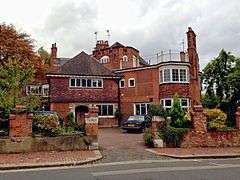William Garnett (professor)
Dr. William Garnett (December 30, 1850 – November 1, 1932)[1] was a British professor and educational adviser, specializing in physics and mechanics and taking a special interest in electric street lighting.
Early years
Garnett was born in Portsea, Portsmouth, England in 1850, the son of William Garnett.[2] In January, 1863, he entered the City of London School, where he was a pupil of Thomas Hall. In the May 1866 examination, he obtained the first Royal Exhibition, tenable at the Royal School of Mines and College of Chemistry, and during the winter session, he studied under Dr. Edward Frankland and Professor John Tyndall, but in the following year, resigned the Exhibition and returned to the City of London School. In April, 1869, he gained the Exhibition for Natural Science at St John's College, Cambridge, and in July of the same year, the Beaufoy Mathematical Scholarship at the City of London School, and commenced residence at St. John’s College in October. The following summer, he was first in the competition for Sir James Whitworth’s Scholarship for Mechanical Engineering, and in 1871, was elected Foundation Scholar at St. John’s College. In January, 1873, he took his degree as Fifth Wrangler, and shortly afterwards, on the opening of the Cavendish Laboratory, he was appointed Demonstrator in Experimental Physics by Professor James Clerk Maxwell. In November, 1874, he was elected Fellow of St. John’s College, and retained his fellowship till his marriage in 1879.[3]
Career
In October, 1876, he became a Lecturer in the Cavendish Laboratory, and continued to lecture there upon mechanics, heat, magnetism, and electricity until 1880, when he declined to be reappointed. In April, 1879, he was appointed by the Senate Examiner in Natural Philosophy in the University of London. Shortly afterwards, he was appointed Lecturer on Physics at St. John’s College. In 1879, 1880, and 1881, he was one of the Examiners in the Natural Sciences Tripos. In April, 1882, the Committee of University College, Nottingham, invited him to accept the Professorship of Mathematics, Physics, and Mechanics. Shortly afterwards, he was appointed Electrician to the Nottingham Corporation; he commenced work at Nottingham in October 1882. During the following summer, he organized a system of technical education in connection with the mechanical department of the College, and fitted up a complete set of engineering workshops. He also became a Lecturer on Mechanics and Physics at Newnham College.[3] In November, 1883, Garnett was appointed Principal[2] and Professor of Mathematics in the Durham College of Science, Newcastle upon Tyne and began that post the following year; he also assisted in planning and erecting the buildings of Durham College of Science. He served as a member of the Executive Council, and was chairman of the Electric Lighting Committee of the Royal Jubilee Exhibition in Newcastle (1887).[2]
Garnett served as Secretary and Educational Adviser to the Technical Education Board (1893-1904).[2] He was an educational adviser to the London County Council and one of H.M. Commissioners for the Exhibition,[4] as well as serving on the Royal Commission's Science Scholarships Committee (1890-1932). Garnett received an Honorary D.CL. from Durham College, and was an Honorary Member of North of England Institute of Mining and Mechanical Engineers.[2]

In 1902-03, he designed a large house for his family, The Wabe, in Redington Road, Hampstead, London.[5]
Later years
He married Rebecca Samways (1879); they had three sons and two daughters; the eldest was (James Clerk) Maxwell Garnett, C.B.E., general secretary of the League of Nations Union, father of (William) John Poulton Maxwell Garnett, director of The Industrial Society, himself father of Virginia Bottomley.[6][7][2] Increasing deafness caused him to resign from his professional affiliations in 1932. He died in the same year.[4] Garnett was a schoolmate and lifelong friend of the British mathematician and physicist, William Mitchinson Hicks.[8]
Partial works
| Wikisource has original works written by or about: William Garnett |
- A treatise on elementary dynamics, for the use of colleges and schools
- An elementary treatise on heat
- An elementary treatise on electricity
- Elementary Mechanics
- Heroes of Science—Physicists
References
- ↑ "Obituary - Dr. William Garnett". Nature. 130: 729–730. November 12, 1932. doi:10.1038/130729b0.
- 1 2 3 4 5 6 Addison, Henry Robert; Oakes, Charles Henry; Lawson, William John; Douglas Brooke Wheelton Sladen (1907). Who's who (Public domain ed.). A. & C. Black. pp. 659–. Retrieved 12 January 2013.
- 1 2 Gray, James (1885). The Electrician. XIV (Public domain ed.). London: George Tecker. pp. 198–. Retrieved 13 January 2013.
- 1 2 Shaw, Evelyn (November 26, 1932). "Dr. William Garnett". Nature. 130: 814. doi:10.1038/130814b0.
- ↑ http://www.hamhigh.co.uk/property/welcome-to-wonderland-the-15-million-home-with-a-curious-history-1-4960189
- ↑ http://www.oxforddnb.com/view/10.1093/ref:odnb/9780198614128.001.0001/odnb-9780198614128-e-33333
- ↑ https://www.independent.co.uk/news/obituaries/obituary-john-garnett-1239782.html
- ↑ Milner, S.R. "William Mitchinson Hicks". Reprinted from "Obituary Notices of the Royal Society of London", No. 4, pp. 392-393, December 1935. The University of Sheffield. p. 393. Retrieved 13 January 2013.
- This article contains public domain text from J. Gray's "The Electrician" (1885).
- This article contains public domain text from H.R. Addison's "Who's who" (1907).